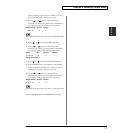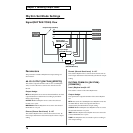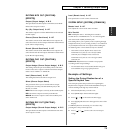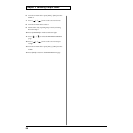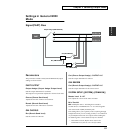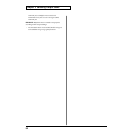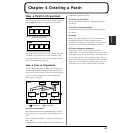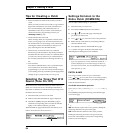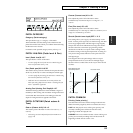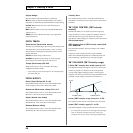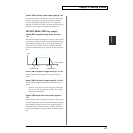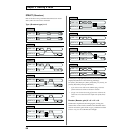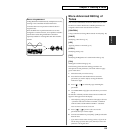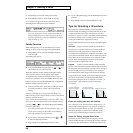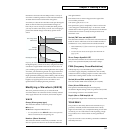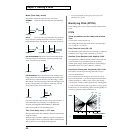
85
Chapter 4 Creating a Patch
Chapter 4
fig.4-07.e
PATCH CATEGORY
Category (Patch category)
This specifies the type, or “category” of the Patch.
The Patch Finder uses this setting. It also determines the
phrase that will be heard when you audition the Patch using
the Phrase Preview feature.
For details on the possible category names, refer to p. 17.
PATCH LVL&PAN (Patch level & Pan)
Level (Patch level)0–127
This specifies the volume of the Patch.
* You can specify the level of each Tone in a Patch using the
Tone Level parameter (TVA p. 95).
Pan (Patch pan)L64–0–63R
This sets the stereo position of the Patch. L64 pans the Patch
all the way to the left, 0 is center and 63R pans it hard right.
* You can specify the pan setting for each Tone in a Patch using
the Tone Pan parameter (TVA p. 95).
* While each Tone in a Patch has its own Pan position, the
Patch pan setting shifts the entire Patch – including all of its
Tones – leftward or rightward.
Analog Feel (Analog Feel Depth)0–127
Traditional analog synthesizers often exhibited a degree of
instability in their tuning. The XV-3080’s Analog Feel feature
can simulate this characteristic. This setting specifies the
depth of Analog Feel that is applied to the Patch.
PATCH OCT&TUNE (Patch octave &
Tune)
Octave (Octave shift)-3–0–+3
This sets the pitch of the Patch in units of an octave (+/-3
octaves).
* This setting can also be adjusted from the PATCH PLAY
page.(p. 20)
Coarse (Coarse tune)-48–+48
This adjusts the pitch of all of the Patch’s Tones
simultaneously in semitone steps over a range of +/-4
octaves.
Fine (Fine tune)-50–+50
This adjusts the pitch of all of the Patch’s Tones
simultaneously in 1-cent steps (1/100th of a semitone) over a
range of 1/2 semitone up or down.
Stretch (Stretch tune depth)OFF/1/2/3
This setting allows you to apply “stretched tuning” to the
Patch. Acoustic pianos typically use stretch tuning, with their
lower range slightly flatter and their higher range slightly
sharper than the actual mathematical tuning ratios dictate.
Stretch is therefore useful when programming a Patch
intended to sound like a real piano. With a setting of OFF,
the Patch’s tuning will be equal temperament. A setting of 3
will produce the greatest difference in the pitch of the low
and high ranges.
This diagram shows the pitch change relative to equal
temperament that will occur in the low and high ranges.
Stretch will have a subtle effect on the way in which chords
resonate.
fig.4-08.e
PATCH COMMON
Priority (Voice priority)
This determines how notes will be managed when the XV-
3080’s maximum polyphony limit is exceeded (128 voices).
LAST: The last-played voices will be given priority, and
currently-sounding notes will be turned off in order,
beginning with the first-played note.
LOUDEST: The voices with the loudest volume will be given
priority, and currently-sounding notes will be turned off
beginning with the lowest-volume voice.
1
2
3
OFF
2
1
OFF
3
Pitch difference from
equal temperament
Parameter value
Low note range High note range



